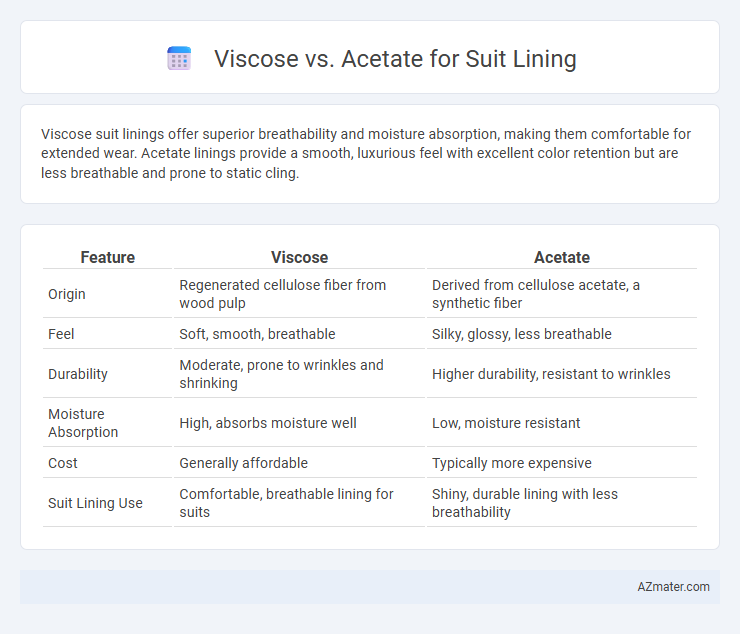Viscose suit linings offer superior breathability and moisture absorption, making them comfortable for extended wear. Acetate linings provide a smooth, luxurious feel with excellent color retention but are less breathable and prone to static cling.
Table of Comparison
| Feature | Viscose | Acetate |
|---|---|---|
| Origin | Regenerated cellulose fiber from wood pulp | Derived from cellulose acetate, a synthetic fiber |
| Feel | Soft, smooth, breathable | Silky, glossy, less breathable |
| Durability | Moderate, prone to wrinkles and shrinking | Higher durability, resistant to wrinkles |
| Moisture Absorption | High, absorbs moisture well | Low, moisture resistant |
| Cost | Generally affordable | Typically more expensive |
| Suit Lining Use | Comfortable, breathable lining for suits | Shiny, durable lining with less breathability |
Introduction to Suit Lining Fabrics
Suit lining fabrics such as viscose and acetate play a crucial role in enhancing garment comfort and durability by providing breathability and smooth texture against the skin. Viscose, derived from natural cellulose fibers, offers excellent moisture absorption and a silk-like feel, making it ideal for high-quality suit linings. Acetate, a synthetic fiber made from cellulose acetate, is prized for its shiny appearance and resistance to wrinkling, though it tends to be less breathable than viscose.
What is Viscose?
Viscose is a semi-synthetic fiber made from regenerated cellulose derived from wood pulp, known for its silk-like feel and breathability, making it a popular choice for suit linings. It offers excellent moisture absorption and comfort, ensuring suits remain cool and dry during wear. Compared to acetate, viscose provides greater durability and resilience, enhancing the longevity of suit linings.
What is Acetate?
Acetate is a man-made fiber derived from cellulose, commonly used in suit linings for its smooth, silky texture and excellent drape. It offers superior moisture absorption and breathability compared to many synthetic fibers, making it comfortable in warm weather. However, acetate is less durable than viscose and may require more delicate care to maintain its appearance and longevity.
Composition and Manufacturing Process
Viscose suit linings are made from regenerated cellulose fibers derived from wood pulp, offering a smooth texture and breathability, while acetate linings originate from cellulose acetate, a chemically modified form of cellulose that provides a silk-like sheen and resistance to moisture. The manufacturing process for viscose involves dissolving cellulose in chemicals to form a viscous solution, which is then spun into fibers, enabling versatility in fabric weight and drape. Acetate production requires acetylation of cellulose, creating fibers with a crisp finish and vibrant dye uptake, often used to enhance the aesthetic appeal and durability of suit linings.
Breathability and Comfort
Viscose suit linings excel in breathability due to their natural cellulose fibers, which wick moisture effectively and provide superior comfort in warm climates. Acetate linings, while smooth and lustrous, tend to trap heat and moisture, making them less breathable and potentially less comfortable during extended wear. Choosing viscose enhances airflow and regulates temperature, crucial for maintaining comfort in tailored suits.
Durability and Longevity
Viscose suit linings offer moderate durability with good breathability but tend to wear out faster due to moisture absorption and friction. Acetate linings provide a smoother, silk-like finish with better resistance to wrinkles and abrasion, enhancing the overall longevity of the suit. Choosing acetate generally results in a more durable, longer-lasting lining suitable for frequent wear.
Appearance and Feel
Viscose suit linings offer a smooth, silky appearance with a natural sheen that enhances the garment's luxury appeal, while acetate linings provide a shiny, glossy finish that appears more synthetic but equally elegant. Viscose feels soft, breathable, and comfortable against the skin, making it ideal for extended wear, whereas acetate tends to be slicker and less breathable, often feeling cooler but less natural. Both materials contribute to a polished suit interior, but viscose is preferred for its breathable texture and natural fiber qualities in higher-end tailoring.
Care and Maintenance
Viscose suit linings require gentle hand washing or dry cleaning to maintain fabric integrity and prevent shrinkage or distortion. Acetate linings demand dry cleaning exclusively, as water exposure can cause fabric damage and loss of shape. Proper storage in a cool, dry place and avoiding prolonged sun exposure help preserve the durability and appearance of both viscose and acetate suit linings.
Cost Comparison
Viscose suit lining generally offers a more cost-effective option compared to acetate, with prices typically ranging 10-30% lower depending on fabric quality and manufacturer. Viscose's affordability stems from its semi-synthetic production process using cellulose fibers, making it less expensive to produce than acetate, which is derived from purified cellulose acetate with additional chemical processing. Choosing viscose can reduce material expenses in suit manufacturing without compromising on breathability and comfort.
Which Should You Choose for Suit Lining?
Viscose offers excellent breathability and moisture-wicking properties, making it ideal for suit lining in warmer climates or for all-day comfort. Acetate features a luxurious sheen and smooth texture, providing a polished appearance but may be less durable and breathable than viscose. Choose viscose for functional comfort and longevity, while acetate suits formal occasions where aesthetics and silk-like feel are prioritized.

Infographic: Viscose vs Acetate for Suit Lining
 azmater.com
azmater.com